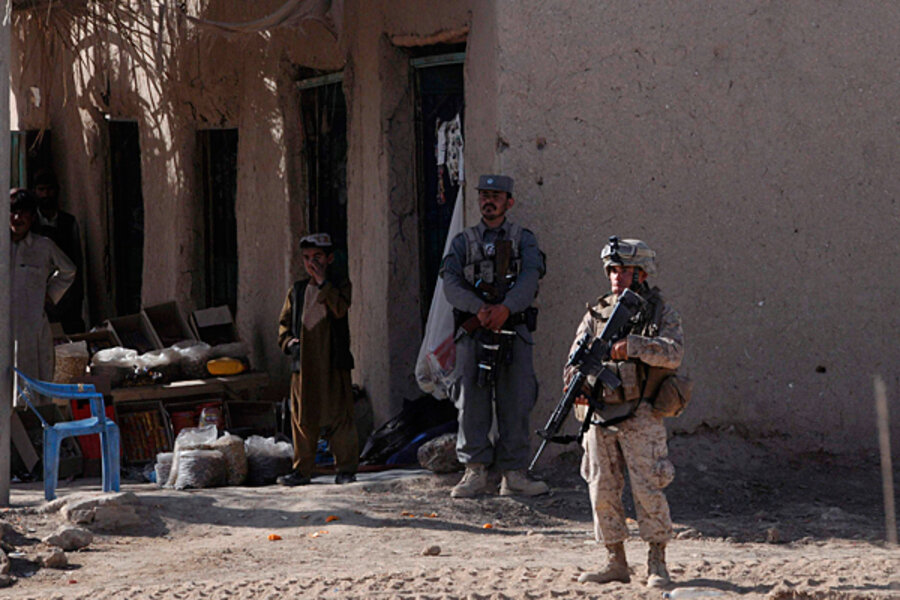Afghanistan war: NATO unfolds blueprint to rebuild Marjah
Loading...
| Lashkar Gah, Afghanistan
Long before Marjah was dragged from sleepy anonymity into one of NATO’s biggest offensives in its nine-year war against the Taliban in Afghanistan, Western governance experts had begun drawing up the town’s future.
Down white-tiled corridors and behind code-locked doors on their base in Helmand Province, a handful of American and British officials planned for months how to turn this swath of irrigation ditches and mud compounds, ruled for two years by Taliban militants and crime syndicates, into a beacon of peace and prosperity.
This is the “build” part of the “clear, hold, build” strategy set out last year by the top NATO commander here, Gen. Stanley McChrystal.
It could become a blueprint for winning the war – if it works.
It is here that the insurgency has raged most fiercely, costing NATO 408 lives and the local population many times more
Kabul takes interest
Governance experiments in Afghanistan have failed before, but this one is different, the planners say, because more resources and thought are being put into it.
The apparent emergence of political will at the highest levels of the Afghan government, after years of neglecting to support their provincial and district counterparts in Helmand, is also a factor.
Last Tuesday a delegation from the capital arrived to discuss agriculture with provincial officials.
Kabul’s interest in Helmand grew last September. That month, Agriculture Minister Mohammad Asef Rahimi visited the town of Nawa, which US Marines had recently cleared of militants, and promised to follow up with development.
“They were horrified. There was nothing there, absolutely nothing,” recalls Peter Hawkins, a British official who accompanied Rahimi's delegation. “There was a good governor, but he was sitting there on his own in a little building built by us. They went back to Kabul with the message, ‘We’ve got to do something, we can’t not do something with this void down there.’ ”
Mapping out a new Marjah
In Marjah a similar void would allow the crime bosses and Taliban commanders just driven out to return. They “exercised far too much control over the population” in the past, says Marlin Hardinger, a US State Department official in Helmand. The “most important and difficult [thing now is to] build better governance.”
Although the insurgency is still flickering in Marjah, it is mainly in the form of roadside bombs strikes, about five a day. Officials, who have access to $500 million for stabilizing Helmand, don’t expect to know if they have won over the population for at least three months.
A map drawn up by the provincial governor and dotted with colored blocks shows what the restoration of sovereignty means in tangible terms: there are bright red schools, yellow agriculture directorates, and courts festooned with the scales of justice.
Green blocks, or police stations, are a point of concern. Thousands of elite officers have been drafted from outside Helmand and charged with maintaining security in the crucial next few months. The force must also shed its predatory and corrupt reputation for the rebuilding of Marjah to succeed, experts say.
“Probably the most challenging and sensitive thing” is improving the police, says Mr. Hardinger, the State Department official.
Rooting out opium
Another challenge will be how to deal with Helmand’s thriving opium economy. Powerful players in the drug trade in the province, such as former governor Mohammad Akhundzada and his police chief Abdurrahman Jan, have much to lose by acceding to a new political economy. Mr. Jan demonstrated his intent to reestablish his influence over Marjah last month when he took control of a local council.
Posed against these strongmen is current Helmand Governor Gulab Mangal, a technocrat who burnished his reputation by busting kidnapping rings and crooked police since taking office two years ago. He has won praise from Western advisers for using the media to spread a message of inclusive government and for traveling around the province to hear complaints from his constituents.
He’s also earned plaudits for his handling of men like Mr. Akhundzada and Jan. “Mangal’s played the technocratic card brilliantly,” says Hawkins, who has worked closely with the governor. “He has managed the situation rather than (1) allowing the situation to manage him or (2) confronting the situation. If you confront the situation in Afghanistan, you’ve lost.”
Mangal will also have to wean farmers away their opium crop without alienating them. Counternarcotics experts have praised his “food zone” program, which combines the stick of poppy eradication with the carrot of improved wheat seed handouts. Although Helmand still produces more poppy than the rest of the world combined, they say there are tentative signs of success.
The new mayor of Marjah, Haji Zahir, is tasked with replicating Mangal’s tactics, for example, reaching out to local leaders in a flurry of meetings.
-----





